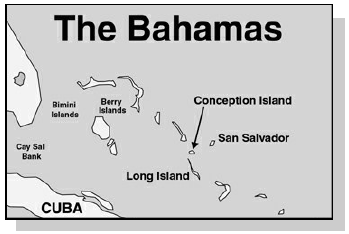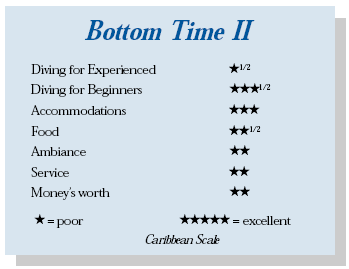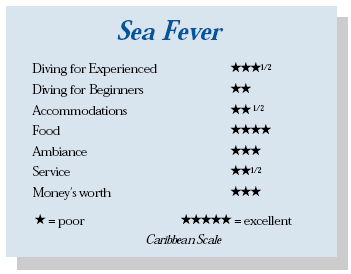Bottom Time Not Well SpentContents of this Issue: One More Bahamas Boat, the Rorqual What You See When You Dive Deeper Readers Lose Money with Scubacan Think You’ve Made Your Last Dive? Editorial Office: Ben Davison Publisher and Editor Undercurrent 3020 Bridgeway, Suite 102 Sausalito, CA 94965 but Sea Fever generates relative heat from the February, 2002 issue of Undercurrent
Live-aboard touring in the Bahamas can be attractive to serious divers: lots of dives, reasonable prices, shorter flights than abroad, Florida departures ... you know the drill. But, with all those advantages, you hope for a good boat and demand good diving. One of our traveling reviewers, Doc Vikingo, ventured out on two boats with different itineraries and reports whether these would be good options for you. As you will see, his experiences were far from perfect ventures . * * * * * * Somewhere between the hot tubs and hot towels of Peter Hughes and the marine campouts of Blackbeard’s, there floats a midrange craft like the Bottom Time II -- a boat where room temperature towels are actually rented. The BTII has several itineraries, including whale excursions to the Silver Banks and wild dolphin trips to Little and Great Bahama Banks. I signed on for the Bimini-Berry Islands- Andros tour, a decision I would later regret. Docked just a stone’s throw from the Ft. Lauderdale Airport, the boat is nearly within walking distance of baggage claim. Since the boat departs at 8 a.m., most guests avail themselves of the local motel package that includes free transfers. The BTII is a substantial aluminum catamaran whose 90-foot length and 31-foot beam scream stability, while two monstrous diesels propel it at upwards of 22 knots. It covers the often-rough 50 miles from Port Dania to Bimini customs in three hours, and cruises so serenely that I could have slept the entire way. It can run circles around the Nekton Pilot and is every bit as stable. Besides, it looks striking from underneath. As it was easy to spot, photogenic and reassuring, I enjoyed ending my dives by gently surfacing between the bodacious pontoons.
A compartment beneath each diver’s seating area, as well as hanger racks allowed for convenient stashing of kits. The dive deck walkways are narrow and we filled the available space, though the leisurely pace kept suiting up from becoming unmanageable. Notably absent are dedicated space and rinse buckets for cameras -- one camera buff used his shipping cases for dunking. Entries are by giant stride at each side of the deck, and exits by sturdy ladders onto wide platforms, but hauling my gear and myself up by a single platform rail wasn’t easy. Hot fills of the boat’s steel 72s often cooled to less than 2,800 psi, which did not cut it with me as I use air liberally and fancy long dives. After some grumbling, I did get more air. The absence of Nitrox is more lamentable. The diving profiles here are absolutely ideal for it. But, perhaps not the diving. You see, I found diving on this itinerary a big disappointment. Though the water averaged about 77 degrees (late May) and vis averaged 50 to 80 feet due to rough weather in the weeks before, it was the tedium and lack of excitement that bummed me out. Moor at a site, drop to 30 to 50 feet, swim around a mostly featureless and unhealthy looking reef, and surface when you’re ready. There was not one bona fide drift dive, nor a worthwhile wall or wreck dive. In fact, I found the topography so ho-hum that I broke out Paul Humann’s book on “Reef Coral Identification” and went to work on the algae section -- a sure indicator of desperation. The walls of the fabled “Tongue of the Ocean” in the Andros area bore no resemblance to those along the Exumas or off New Providence. The mostly featureless sand bottom meandered downward to between 85 and 120 feet, then simply dropped off. Without massive plate corals, tube sponges or other goodies that make the “Tongue” a delight in other locations, I found no point in accumulating much of a nitrogen load. Despite decent wrecks around Bimini (e.g., the Sapona and Bimini Barge), our sole wreck dive was a night foray to the Hesperus. Consisting of several pieces of disconnected, badly rusted metal spread along a sand and turtle grass bottom at 20 feet, it greatly disappointed. I did, however, enjoy an ancient loggerhead turtle festooned with remoras and a hogfish in its distinctive night camouflage. A few sites were more interesting. Caves and Caverns and Victory Reef, north of Bimini, had some fun crevasses and swim-throughs, while at Elkhorn Reef off Andros an enormous spotted eagle ray twice cruised by at close range. Fish Bowl at Chub Cay and Turtle Rocks at Bimini were loaded with marine life. I enjoyed a juvenile spotted drum and gray angelfish, a massive terminal phase blue parrotfish, and a colony of yellowhead jawfish popping like steam from a calliope. On the Fish Bowl, I spotted both an almaco jack and a small wahoo, not creatures one expects to see on a shallow reef. At Truck Lagoon off Chub Cay, a large school of ballyhoo remained uncharacteristically still just beneath the surface. But, this isn’t legendary diving and because the crew seldom dives, one is left on his own for critter spotting. However, the crew is competent, though rather standoffish. I seldom saw Captain Roger, though the smooth mechanical stirrings throughout the boat and its excellent state of repair bespoke his presence. Second in command, Wade is a widely traveled man of many skills, from boat builder to chef. Two mates served ably, if laconically, busing meals, helping divers, and flushing away “the presents” left by the BTII ’ s resident canines, Tiki and Oopy. The exception to the crew’s aloofness is the effervescent Erika, the captain’s wife. When he left the computer industry for the BTII, she left her job as a school psychologist and headed off to culinary school before joining him. What she learned was apparent. Breakfasts ranged from spinach frittata to scrambled eggs, sausage patties and bagels to fresh blueberry rolls. Lunches included a variety of sandwiches and wraps. Dinners, from grouper to Beef Bourgogne, were accompanied by fresh green salads and desserts such as hot brownies with ice cream. Seconds were available, and she accommodated special diets with advance notice. Between meals, drinks and snacks such as pretzels, granola bars and fresh fruit were readily available. Sodas, beer, wine and hard spirits were reasonably priced at the honor system “Narcosis Lounge.” On our first night out, Erika ceded dinner to the group’s preeminent character, “Pigman.” When not off diving in his red, white and blue skin or modeling women’s tropical wear, this Prince of Pulled Pork serves up the most toothsome barbecue in the Kill Devil Hills, NC environs. He brought along 20 lbs. of prized product and a variety of sauces. Now that’s good eatin’. Of all the food service, however, my favorite was being greeted on the dive deck with a pot of hot conch chowder, ginger chicken rice, or black bean and vegetable soup, after the second morning’s dive. And speaking of nice touches, how ineffably sweet it was to rise in the morning to Erika singing a gentle tune and playing the chimes. So, it was a good time, which groups of divers usually have, but the diving
was a big disappointment. PS: On my trip, the necks of all tanks showed serious corrosion at the juncture of the valve. After a few dives, the inlet filter on my serviced regulator bore the telltale brown dust of internal tank corrosion. My buddy’s first stage looked just like mine, and three other divers commented on rust in their regulators. All tanks I checked were in hydro, but none bore a VIP sticker. Before going to press I spoke with Capt. Roger Maier, who assured me that the tanks are all off for VIP and hydro and will be fully serviced for their next scuba trips. At the end of July, I boarded a second vessel of the bring-your-own-towel type, the MV Sea Fever, for a trip to Cay Sal Bank, which is between the Florida Keys and the north coast of Cuba. About 115 miles south of Bimini, it’s dotted with desolate little stone islands that serve as nesting grounds for shearwaters and a refugee for fleeing Cubans awaiting clandestine pick-ups to Miami. The Sea Fever is a monohull, 90 feet in length and 22 feet in beam. Its three
12-cylinder diesels (you’d need some serious bad luck to get stranded by engine
failure) provide a cruising speed of 16 knots with a top end around 21. Doing duty
as a live-aboard for more than 20 years, this aging but adequately maintained converted
oil crew boat holds up to 16 passengers in seven lower deck cabins, each with
central A/C and a small (but operational) sink. Two cabins can stack divers up the
wall three high, but mercifully they book only two to these quarters. My coffin-like
cabin, which had no porthole, accommodated two persons if storage was done with care
and only one of us moved about at a time. Making the Sea Fever’s 8 a.m. departure from the Sunny Isles section of northern Miami means one should stay the previous night at one of the midscale motels that line Collins Avenue. As I waited for my room at the Monaco Ocean Beach Resort, I moseyed to the beach and flopped onto a rickety wooden chaise lounge under a dilapidated palapa. I was told that this amenity was $12/day to rent, and all lounges on the beach and poolside were rental only. So, off to the motel bar (no charge for a stool) where generous rounds of Cuba libres and Coronas expedited bonding within the group of 16 handpicked divers. From a ready-for-romance salesman who carried a comb while diving to present his best image as he rose from the depths, to a foreman from rural mid-America who donned clean white overalls, T-shirt and sneakers on dress occasions, group members proved to be capable of looking after themselves underwater. And that’s an asset, as the Sea Fever affords exceptional diver freedom, allowing divers to follow their own plans and profiles. Captain James, on board for more than two years, though a bit detached from his passengers, was clearly a whiz at matters mechanical. He competently attended to various breakdowns, such as when, during a rough crossing, a massive spare prop fell from its space, knocking out a section of water pipe. The jewel of the crew, known as Redman for obvious reasons, was an old salt with Navy SEAL experience, and had coffee and a “good morning” brewing at 5 a.m. daily. While occasionally serving as dive leader and fix-it guy, he ran the ship’s galley. Brooke, a friendly young woman, pitched in on whatever needed doing, usually with a smile. Deanna, a hardworking and good-natured woman, was gladly up to share a smoke and some gab when not working the dive deck. One of the owners, Charlie, a retired attorney from North Carolina, was so low profile it often seemed he was absent from the craft. Getting back to His Redness, his meals were fresh, varied and tasty. Breakfast might be blueberry pancakes, omelets, or waffles, with bacon, ham or sausage, and a side of orange slices. A basket of bagels and English muffins, along with peanut butter and jelly, was laid out. Lunch varied from tuna salad on croissants to hearty beef soup. Afternoon snacks might be egg rolls, buffalo wings, or cheese and crackers. Dinners included chicken and shrimp curry on white rice, prime rib cooked to taste or tuna steaks, served with a vegetable and a dynamite fresh green salad. Apple pie ala mode and fresh chocolate brownies comforted those with a sweet tooth, while beer at $6 a six pack (!) comforted others. Sodas and fruit juices were gratis, as was wine with dinner. If you’re into hard spirits, BYOB. On the partially covered dive deck, all the seats have a spacious plastic bin below. They fill cylinders in place between dives. Although the space is snug, I could suit up and move about with relative ease. A large gear rinse bucket and one dedicated to photo equipment pleased the picture buffs, as did the carpeted, four-tiered camera table. Exits are by giant stride from each side of the craft, and entries are on an aft platform with double ladders. My major gripes were the initially short fills and slow tank turnaround times -- up to two hours: due to the heat below decks, only one of the two major compressors could be operated at a time and this restricted the boat’s DNAx membrane Nitrox system to mixes of EAN32 or less. But, it was nice to have the freedom to dive as one wished, though that can mean that some suicidal diver might be on board, such as the repeat guest who seemed sold on Sea Fever because the crew either didn’t notice or weren’t bothered by his near obsessional need to break 200 feet at least once a day. After the 3.5-hour crossing to Bimini, we cleared customs and were on our first dive at The Kinks. A lamentably lacking site even by check-out dive standards, the water was now an inviting 84 degrees. Next, we dived the more interesting Caves and Caverns with its swim-throughs and grooves. The following day we dived Red Hole, which is actually a blue hole starting at 35 feet that I could easily fin around, passing Bermuda chub, mutton snapper and long strands of wire coral. A swim-through on one side was filled with copper sweepers. Next stop was the Black Hole, an abyssal formation circled on the inside by the occasional Caribbean reef shark. Nice holes, but nothing to write home about, as with most blue holes. The next dive, however, this on Cay Sal Banks, definitely knocked my scuba socks off. Only 25 to 30 feet, Dog Rock has patch reef, coral heads and swim-throughs, but was exceptional thanks to silversides in the tens of thousands. Surrounded by vibrant green, yellow and purple sea fans, I kneeled on the sand in transcendent silence as the little fish enveloped me like so many splatterings of mercury. Their presence drew predators, of course. A dark pack of black jacks plied the area, as did a pair of barracuda. A night dive here revealed critters such as night shrimp, hatchetfish, cardinalfish and a Spanish lobster. Next morning’s plunge at Rope on the Wall, where I briskly drifted at 95 feet, yielded one of my best creature sightings ever: what had to be a 500 lb. Goliath grouper (previously known as a jewfish). Lolling in a crevasse at 110 feet, this leviathan sported a mouth that could easily have swallowed me whole. I was mesmerized. A later 10-to-15 foot dive at Blue Lagoon, a site I called Fry Central, exploded with dazzling piscine youngsters. A single stand of thin-leaf lettuce coral contained juvenile and intermediate stages of yellowtail damselfish, rock beauties, blue tang, and longspine squirrelfish and puddingwives, soapfish, dusky damselfish and a half-inch-long spotfin butterflyfish that was just as cute as it could be. Three bar jacks and a great barracuda, working like marine-herding dogs with a school of scad, maneuvered the flitting mass of polarized quicksilver into a fatigued bait ball. Several repetitious and unexciting dives along various segments of the wall followed. Combined with less-than-perfect weather, these dives caused us to vote to head back to Bimini. Arriving in the early evening, we had dinner and descended upon the north island’s two fabled saloons. The Compleat Angler, a favorite of Hemingway while he penned “Islands in the Stream,” is paneled in dark wood adorned with photos of him. Its band plays Caribbean-style music to swaying Jimmy Buffett souls searching for a moment of meaningless connection. Down the street, near Chalk’s seaplane landing lot, is the End of the World Bar. A graffiti-covered, cramped wooden shack with sand on the floor, it was recently remodeled, making it even smaller. However, all you End of the World devotees will be pleased to hear that the intimate undergarment motif has been retained. Diving at Bimini on our last day included a nice drift deep along Tuna Alley where I passed through enchanting schools of actively feeding Creole wrasse, yellowfin snapper, blue chromis and black durgeons. The final dive at a shark feeding area, sans chumsickle, drew several Caribbean reef sharks in for a very close view. Sea Fever’s Web site advertises this itinerary as having deep wall dives, seven blue holes and blowhole caves where one can scuba through and surface within the island. Yet, we visited only two blue holes, no blow holes and did many dives along the same section of Elbow Cay. The weather, though not bad by my reckoning, may have had something to do with this, but I never heard an explanation. I am left with the strong suspicion that diving these sites was just easier and more economical. Nonetheless, we had some quite decent dives along the way and, clearly, this was the better itinerary of the two I took. -- Doc Vikingo |

I want to get all the stories! Tell me how I can become an Undercurrent Online Member and get online access to all the articles of Undercurrent as well as thousands of first hand reports on dive operations world-wide
| Home | Online Members Area | My Account |
Login
|
Join
|
| Travel Index |
Dive Resort & Liveaboard Reviews
|
Featured Reports
|
Recent
Issues
|
Back Issues
|
|
Dive Gear
Index
|
Health/Safety Index
|
Environment & Misc.
Index
|
Seasonal Planner
|
Blogs
|
Free Articles
|
Book Picks
|
News
|
|
Special Offers
|
RSS
|
FAQ
|
About Us
|
Contact Us
|
Links
|
3020 Bridgeway, Ste 102, Sausalito, Ca 94965
All rights reserved.

 On the main deck, the cabins
are forward and the covered dive
deck aft. The upper deck houses a
largely uncovered sundeck and an
air-conditioned dining salon and
lounge with a TV, VCR and stereo.
Our group of 25 occupied all of the
boat’s four double bed cabins and
ten twin bunk quarters, which were
about standard size for liveaboards.
With the upper bunk and
area under the lower bed, I had
plenty of storage room (empty luggage
could be stored elsewhere).
Those sharing cabins, however, were
tightly packed. There are no
ensuite bathrooms, though showers
(plenty of hot water) and toilets (which are kept clean) were usually available
without an undue wait. However, if one failed to close the metal door, its banging
in the middle of the night can wake the dead. While each cabin had a small sink,
the water line was not operating. The A/C was so vigorous, I sometimes had to place
a towel and book over the vent, but in the Bahamian summer, it is better too cool
than too warm.
On the main deck, the cabins
are forward and the covered dive
deck aft. The upper deck houses a
largely uncovered sundeck and an
air-conditioned dining salon and
lounge with a TV, VCR and stereo.
Our group of 25 occupied all of the
boat’s four double bed cabins and
ten twin bunk quarters, which were
about standard size for liveaboards.
With the upper bunk and
area under the lower bed, I had
plenty of storage room (empty luggage
could be stored elsewhere).
Those sharing cabins, however, were
tightly packed. There are no
ensuite bathrooms, though showers
(plenty of hot water) and toilets (which are kept clean) were usually available
without an undue wait. However, if one failed to close the metal door, its banging
in the middle of the night can wake the dead. While each cabin had a small sink,
the water line was not operating. The A/C was so vigorous, I sometimes had to place
a towel and book over the vent, but in the Bahamian summer, it is better too cool
than too warm. While Captain Roger attributed the poor condition of the reefs to diver pressure, it’s more than
that. Both coral and sponge were sparse,
and the former largely without colorgiving
symbiotic zooxanthellae. There was
an unusual amount of filamentous algae
of a sickly grayish green hue, which has
been around San Salvador for decades and
in other areas as well. So, for the last
dive of the trip, rather than visit one
more reef, we voted to search for dolphin. Roger delivered, finding several
playful pods of Atlantic spotted dolphin.
We got in the water with one pod, with
which I snorkeled for an edifyingly long
while. It was a grand way to close an
otherwise uneventful journey.
While Captain Roger attributed the poor condition of the reefs to diver pressure, it’s more than
that. Both coral and sponge were sparse,
and the former largely without colorgiving
symbiotic zooxanthellae. There was
an unusual amount of filamentous algae
of a sickly grayish green hue, which has
been around San Salvador for decades and
in other areas as well. So, for the last
dive of the trip, rather than visit one
more reef, we voted to search for dolphin. Roger delivered, finding several
playful pods of Atlantic spotted dolphin.
We got in the water with one pod, with
which I snorkeled for an edifyingly long
while. It was a grand way to close an
otherwise uneventful journey. A large area below the lower bunk proved
useful for storage, and you can stow empty luggage around the boat. Dark curtains
can be drawn across the bunk for privacy.
Staterooms with a double/single or
with two double bunks are also available.
The 22 bodies (which included six
crew) had to adjust their constitutionals
to the three heads (two with showers,
plus a fresh water hose on the rear
deck). The head that shared a common
wall with my cabin (#4) has a commode
elevated on a throne-like arrangement to
cover a pump whose vigorous whirrs irritatingly
roused me most mornings. The
1,000 gallon/day reverse-osmosis system
fell short of providing a luxurious
water supply, so no morning showers and
occasionally the rinse bucket water could
not be changed.
A large area below the lower bunk proved
useful for storage, and you can stow empty luggage around the boat. Dark curtains
can be drawn across the bunk for privacy.
Staterooms with a double/single or
with two double bunks are also available.
The 22 bodies (which included six
crew) had to adjust their constitutionals
to the three heads (two with showers,
plus a fresh water hose on the rear
deck). The head that shared a common
wall with my cabin (#4) has a commode
elevated on a throne-like arrangement to
cover a pump whose vigorous whirrs irritatingly
roused me most mornings. The
1,000 gallon/day reverse-osmosis system
fell short of providing a luxurious
water supply, so no morning showers and
occasionally the rinse bucket water could
not be changed. Diver’s Compass: BTII runs a number of itineraries, including dedicated
whale and dolphin trips. Boat available for charter.
Packages from $1,395. E-6 and video processing on board. Videos
of whale and dolphin experiences for sale. Don’t go if you are
not comfortable with two pleasant and clean dogs occasionally begging
in the eating area and relieving themselves on the dive deck.
Diver’s Compass: BTII runs a number of itineraries, including dedicated
whale and dolphin trips. Boat available for charter.
Packages from $1,395. E-6 and video processing on board. Videos
of whale and dolphin experiences for sale. Don’t go if you are
not comfortable with two pleasant and clean dogs occasionally begging
in the eating area and relieving themselves on the dive deck.
